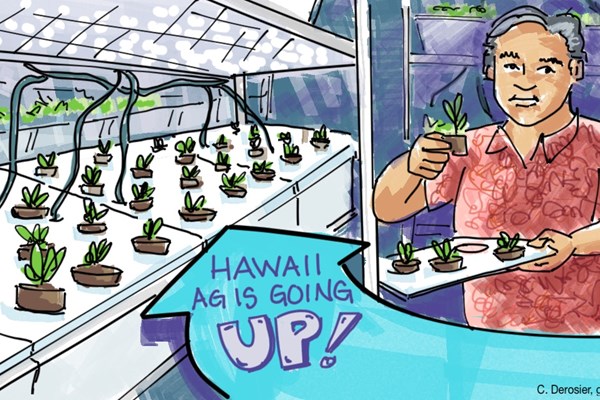Kakaako specialty farm finds a new niche
Jul 09, 2020

Our weekly series continues, talking story with local farmers, ranchers, and other food producers about their crucial efforts to sustain our communities during the coronavirus pandemic.
With uncertainty looming, focus shifts to everyday customer
A conversation with
Kerry Kakazu, President of MetroGrow Hawaii
By Dani Douglass
Urban Honolulu is probably not the first place that comes to mind when you think about Oahu farms. But in the heart of Kaakako lies MetroGrow Hawaii, an indoor vertical farm that is the first of its kind in Hawaii to use nontraditional growing methods requiring no soil or sunlight to grow specialty crops like microgreens and shoots.
The farm’s main clientele consists of many of Honolulu’s hottest restaurants. Chefs use the items, such as a shoot that grows in the dark and tastes like sweet corn (golden corn), to garnish their dishes. The farm also grows various types of lettuce, including the ice plant, a salty tasting succulent ground cover that pairs well with seafood dishes.
At the helm of the innovative operation is Kerry Kakazu, a plant physiologist, whose passion for botany, technology and food drove him to establish the farm in 2013. Kakazu and his part-time staff of three use hydroponic and aeroponic growing methods to produce 14 types of microgreens and shoots as well as three varieties of lettuce. The hydroponic technique uses a flood-and-drain system where water rises up and down below the plant level. With aeroponics, spray nozzles mist the root of the plant with nutrients. Less water means there is more oxygen to help plants grow faster.
Before the COVID-19 pandemic began earlier this year, MetroGrow Hawaii was fulfilling regular orders to a growing list of restaurant accounts. It had also just moved into a larger space and was in the process of opening a storefront to encourage more retail sales. When restaurants closed and switched to offering limited take-out menus, Kakazu quickly pivoted the business. He was able to get financial assistance to keep his staff and operations going. He ramped up online sales and is now more focused on what the everyday consumer wants.
“We are growing more of the leafy greens that appeal to consumers and less of the garnishes that chefs use for dine-in plate appeal,” he said. “We’ve also had to be more flexible in accepting order changes and accommodating last-minute deliveries.”
Kakazu is also focusing on diversifying his product mix to the items in which customers are most interested. He is selling seedlings to hobby growers, looking into offering do-it-yourself home grow kits, and working to increase his supermarket sales. In the new space, he and his team are working to fast-track the retail storefront’s opening while still maintaining online sales. Kakazu also has his eye on the future and is devoting time to research, development, and improving his production methods in anticipation of increased sales down the road.
Kakazu shared that there has been an increase in demand for local produce. Still, he is uncertain how much is driven by the pandemic versus a desire for high-quality, clean, fresh products. He believes that the general public now has an improved understanding of how farmers fit into Hawaii’s economy, and want to support their efforts. A challenge that still exists has to do with the pricing of local produce in a budget-conscious, depressed economy.
“It’s going to be tough for small farmers to have the kind of production scale to compete with imported produce unless the item is unique to Hawaii or hard to transport (from the Mainland or elsewhere abroad),” he explained.
Despite the challenges, he sees an upside to the crisis for the farming industry. “It stresses the need to diversify our revenue sources and forces us to work at it more quickly,” Kakazu said.
There have been a handful of impactful resources available to farmers through the pandemic, such as online farm directories and sales options, including products in food hubs, and community-supported agriculture (e.g., CSA bag deliveries) and farmers markets. Unfortunately, these don’t make up for losses from being unable to sell to restaurant and hotel food and beverage businesses.
“It was already hard for most farms to be profitable because the profit margins of crop sales are so small, but this is accelerating the need to explore alternatives,” he said.
Those alternatives are certainly viable, and farmers have the growing side of the equation down. According to Kakazu, support from government and private organizations, including financial investments to aid increased online sales capabilities, offset delivery costs and increase research and development of innovative farming methods, is what is necessary to ensure the sustainably of farms and farmers.
Follow MetroGrow Hawaii on Instagram at @metrogrowhawaii.
Categories
- Clean Transportation (103)
- Renewable Energy (65)
- Agriculture Story Series (20)
- Local Food (111)
- News Releases (19)
- Promotions and New Hires (4)
- Less Waste (8)
- Freshwater (16)
- Our Ohana (15)
- In the News (5)
- careers (1)
- Blog (1)
- clean energy (2)
- PUC (1)
- Ulupono Video Podcast Series Talk Story Room (1)
- Bills (1)
- Legislature (1)
- DA BUX (1)
- Electric Vehicle (1)

